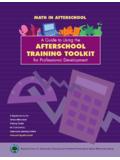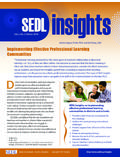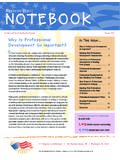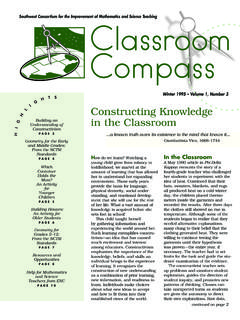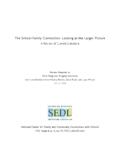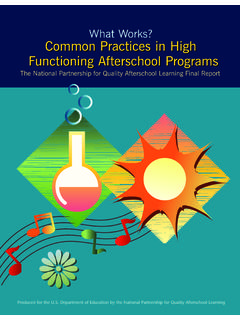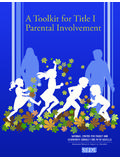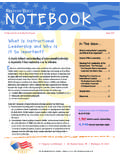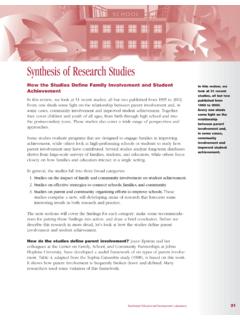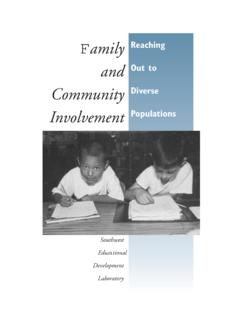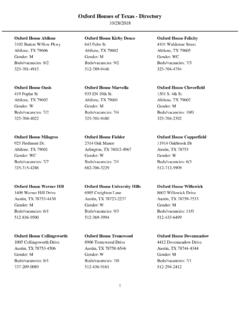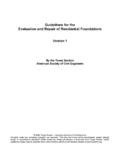Transcription of School, Family, & Community Connections
1 Diversity SEDL Advancing Research, Improving EducationSchool, Family, & Community ConnectionsAnnual Synthesis 2003 DiversitySchool, Family, & Community ConnectionsMartha BoethelContributors Amy Averett Joan Buttram Deborah Donnelly Catherine Jordan Margaret Myers Evangelina Orozco Lacy WoodSEDL Advancing Research, Improving EducationAnnual Synthesis 2003 National Center for Family and Community Connections with SchoolsSEDL4700 Mueller , texas 78723 Voice: 512-476-6861 or 800-476-6861 Fax: 512-476-2286 Web site: : 2003 by Southwest Educational Development Laboratory (SEDL). All rights reserved. No part of this publication may be reproduced or transmitted in any form or by any means, electronic or mechanical, including photocopying, recording, or any information storage and retrieval system, without permission in writing from SEDL or by submitting a copyright request form accessible at on the SEDL Web publication was produced in whole or in part with funds from the Institute of Education Sciences, Department of Education, under contract number ED-01-CO-0009.
2 The content herein does not necessarily reflect the views of the Department of Education, or any other agency of the government, or any other source. Table of ContentsAcknowledgments.. iiiExecutive Summary.. v1. IntroductionPurpose and intended audiences .. 1 Scope of the report .. 1 How the synthesis is organized .. 3 How the synthesis fits into a larger context .. 42. About the StudiesWhat matters in looking at research.. 5 Selection procedures.. 8 How the studies address key concepts.. 11 Conceptualizing family and family involvement .. 18 Alist of studies by category.. 20 Table 1: Types of studies by research method .. 21 Table 2: Populations addressed.. 22 Table 3: Educational levels addressed .. 23 Limitations of the research.
3 243. What the Research Says (and Doesn t Say).. 254. Putting the Research into Practice.. 71 References.. 77 Index.. 85iSouthwest Educational Development LaboratoryiiNational Center for Family & Community Connections with SchoolsDiversity: School, Family, & Community ConnectionsiiiSouthwest Educational Development LaboratoryAcknowledgmentsThe Southwest Educational Development Laboratory (SEDL) is a private nonprofit education research and development corporation based in Austin, texas . SEDL is committed to solving the significant problems communities and school systems face to ensure a quality education for alllearners. It is one of ten Regional EducationalLaboratories in the United States funded by the Department of Education.
4 It serves Arkansas, Louisiana, New Mexico, Oklahoma, and December 2000, SEDL created the National Center for Family and CommunityConnections with Schools (the Center) to serve as a national resource to schools, Community groups, research organizations, policymakers, and families. The Center creates bridges between research and practice - linking people with research-basedinformation and resources they can use to effectively connect schools, families, and acknowledges the Center s steering committee members who gave their time and expertise to the development and review of this research synthesis: Howard S. Adelman, Center for Mental Health in Schools, University of California, Los Angeles Nancy Chavkin, Center for Children and Families, texas State University Pat Edwards, National Center for Community Education Joyce Epstein, Center on School, Family, and Community Partnerships, Johns Hopkins University Arnold Fege, Public Education Network Karen Mapp, Institute for Responsive Education, Northeastern University Milbrey McLaughlin, Stanford University Maria R.
5 Montecel, Intercultural Development Research Association Kris Olson, Parents for Public Schools, Inc. Terry Peterson, Resource Network for Community Education and Afterschool Programs, University of South Carolina Bobby Starnes, Center One ProjectSEDL especially wishes to thank Ludwig Van Broekhuizan for his advice and review ofour work, Lana Castle and Johanna Gilmore for editorial services, and Jane Thurmondand Shaila Abdullah for design and layout : School, Family, & Community ConnectionsivNational Center for Family & Community Connections with SchoolsvSouthwest Educational Development LaboratoryExecutive SummaryThis research synthesis is the third in a series of reports to help local school, Community ,and family leaders obtain useful research-based information about key educationalissues.
6 This synthesis addresses diversity as it relates to student achievement and School, family, and Community Connections . Scope. The literature on diversity includes a wide range of student and family characteristics and affiliations. This synthesis focuses specifically on three categories: race or ethnicity, culture (including language), and socioeconomic status. The need toimprove academic achievement among diverse student populations notably AfricanAmerican, Latino, Native American, immigrant and language minority students, andstudents from poor families is one of the most persistent and challenging issues thateducation faces. This research synthesis looks at the roles families can and do play inaddressing that issue. The report also explores barriers to involvement for minority and low-income families, strategies that have been used to address those barriers, andrecommendations that local educational leaders can adapt to address their specific We identified 64 studies with focuses and methodologies that met our basiccriteria.
7 From the array of information among these studies, we identified seven broadfindings that summarize the overall knowledge base related to family, Community , andschool Connections among minority and low-income populations:1. No matter their race, ethnicity, culture, or income, most families have high aspirations and concerns for their children s success. However, there are limitedfindings as to whether minority and low-income families high aspirations for theirchildren have a positive impact on students school Families from racial, ethnic, and cultural minorities are actively involved in theirchildren s schooling, although their involvement may differ somewhat from those of White, mainstream families. The extent and types of involvement amonglow-income families may be linked to poverty and economic Family and school staff reports on the extent of family involvement and schooloutreach tend to be inconsistent, with the differences increasing in schools withlarger minority populations.
8 The reasons for such inconsistencies are not clear. 4. Research studies have identified barriers to minority and low-income family involvement in their children s schooling barriers that schools often can helpovercome. These barriers include contextual factors (particularly time constraints, childcare needs, and transportation problems); language differences; cultural beliefs aboutthe role of families in their children s schooling; families lack of knowledge andunderstanding of educational processes; and exclusion and discrimination issues. 5. Research findings are limited and inconsistent regarding the extent to which increasedfamily involvement is linked to improved academic achievement among minority andlow-income student populations.
9 Findings specifically addressing the effectiveness offamily involvement programs in boosting student achievement are also some research findings are encouraging, too little high-quality research hasbeen conducted to support a firm The research base is thin, but some intervention strategies appear to be promising instrengthening family- Community -school Connections among minority and low-incomestudent Some studies suggest that, in seeking to close the achievement gap, it is necessary toaddress the complex interactions among families, communities, and schools. Focusingon only one of these factors is not these findings reflect, much more rigorous, high-quality research needs to be done before it is possible to draw firm conclusions about the ways in which families,communities, and schools can and do influence achievement among specific student populations.
10 The 64 studies, we were able to make some recommendationsthat may help to strengthen local diversity programs and practices. Because the researchbase is so thin, these recommendations should be taken as tentative, subject to the needfor both local wisdom and further for building relationships among schools, communities, and families include: Adopt formal school- and district-level policies that promote family involvement,including an explicit focus on engaging families who reflect the full diversity of thestudent population. Demonstrate active and ongoing support from the school principal. Honor families hopes and concerns for their children. Acknowledge both commonalities and differences among students and families.
